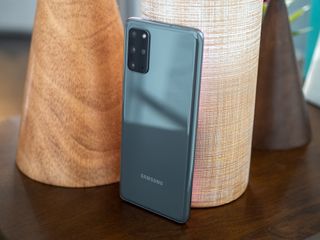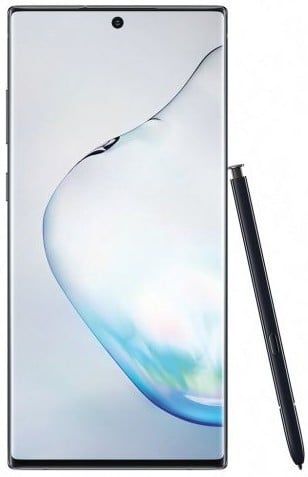Samsung Galaxy S20 Plus vs. Galaxy Note 10 Plus: Which should you buy?

Samsung Galaxy S20+

The Galaxy S20+ has a host of new features, but its differentiating feature is the 120Hz display. Samsung finally made the switch to 120Hz this year, and the result is a display that is the best you'll find on any phone today. You also get the latest hardware, an enticing 64MP zoom lens with 3x optical/30x hybrid zoom, 5G connectivity, and new color options.
Samsung Galaxy S20+
120Hz goodness
Samsung Galaxy Note 10+

The Note 10+ has plenty to offer in 2020, but it falls short in a few areas. The screen's 60Hz refresh rate means you lose out on silky smooth navigation, and it doesn't have 5G connectivity. You still get all the extras, and the S Pen continues to be a standout for the Note series. If you're interested in a stylus, the Note 10+ is the way to go.
Samsung Galaxy Note 10+
Get it for the stylus
The Galaxy S20 series is launching less than six months after the introduction of the Note 10 series, and Samsung isn't making any radical design changes here. There are a few refinements, but the design aesthetic is unchanged. However, the hardware has received considerable upgrades for 2020, so let's see how Samsung has differentiated the S20+ from the Note 10+.
Similar design on both phones, but the Galaxy S20+ has exciting hardware upgrades
Of all the models in the Galaxy S20 series, the S20+ is the one that resembles the Note 10+ the most. It has nearly the same dimensions, and at $1,000, it costs $100 more than the Note 10+. The design is largely unchanged as well, with Samsung bringing the Infinity-O cutout from the Note 10+ to the S20+. The only major difference on the design front is that the Note 10+ is 3.5mm wider, and that's because of the S Pen housing.
The added width makes the Note 10+ unwieldy, but you won't notice it after a few days. The biggest issue with the Note 10+ is the positioning of the power button — which is on the left side. Samsung fixed this particular mistake with the S20+, with the power button once again taking its place on the right side of the phone. The S20+ is also 10g lighter than the Note 10+ while featuring a larger 4,500mAh battery.
The biggest change from the Note 10+ to S20+ is the 120Hz panel, camera hardware, and 5G connectivity.
While the S20+ doesn't have a lot of changes on the design front, it boasts considerable hardware upgrades. The marquee addition this time is the 120Hz AMOLED panel — after missing out on the high refresh rate bandwagon last year, Samsung is going all-in on 120Hz displays with the S20 series. The S20+ has a stunning QHD+ AMOLED panel, and you get a 120Hz refresh rate, making it the display to beat right now.
Samsung somehow manages to eke out a little more vibrancy and brightness out of its panels with every new generation, and at this point, it is competing with itself. The QHD+ AMOLED panel on the Note 10+ is incredible in its own right, but with the S20+ you're getting just that little bit extra thanks to the 120Hz refresh rate. That makes a huge difference in day-to-day usage — once you get accustomed to the screen on the S20+, you wouldn't want to go back to a regular 60Hz display, even one as good as the Note 10+. To be fair, you'll only be able to unlock 120Hz on the S20+ at FHD+ resolution, so at QHD+ both devices are on an equal footing.
Be an expert in 5 minutes
Get the latest news from Android Central, your trusted companion in the world of Android
The S20+ also offers considerable hardware upgrades. Running the show is Qualcomm's latest Snapdragon 865 chipset, and the highlight this time is that 5G connectivity is standard across all three S20 models. The S20+ offers 5G over both sub-6 and mmWave, and if you're eager to test out the next generation of wireless connectivity, the S20+ is the obvious choice.
Samsung has retained the same 12MP resolution for the primary camera, but the sensor itself is brand new. But the main talking about on the camera side of things is the 64MP zoom lens that offers 3x optical zoom and 30x hybrid zoom. Samsung is touting significant gains in image and video recording abilities with the S20+, with the manufacturer trying to close the gap to Google in this area.

The S20+ is available with 12GB of RAM as standard — same as the Note 10+. Where the latter has an edge is with internal storage: the S20+ has 128GB for the base version and 512GB for the high-end model, whereas the Note 10+ is available with 256GB and 512GB options. So you're essentially getting the same amount of RAM and double the internal storage with the Note 10+.
That said, the S20+ features the latest LPDDR5 RAM module that consumes less power while delivering faster data access. You're also getting a larger 4500mAh battery on the S20+, but the charging standard is unchanged. Both phones support 15W wireless charging, and the ability to wirelessly charge other devices, but only the S20 Ultra supports the same 45W wired fast charging that debuted with the Note 10+ last year — the S20+ only does 25W. You'll also find the same IP68 water resistance as well, and they have the same in-screen fingerprint sensor.
Both phones are also identical when it comes to the software side of things. You get Android 10 based on One UI 2.0, and Samsung introduced a host of new features to its custom skin.
| Category | Samsung Galaxy S20+ | Samsung Galaxy Note 10+ |
|---|---|---|
| Operating system | Android 10 One UI 2.0 | Android 10 One UI 2.0 |
| Display | 6.7-inch Dynamic AMOLED 3200x1440 (20:9) HDR10+ Gorilla Glass 6 | 6.8-inch Dynamic AMOLED 3040x1440 (19:9) HDR10+ Gorilla Glass 6 |
| Chipset | Snapdragon 865 1 x 2.84GHz A77 3 x 2.42GHz A77 4 x 1.80GHz A55 7nm | Snapdragon 855 1 x 2.84GHz Kryo 485 3 x 2.41GHz Kryo 485 4 x 1.78GHz Kryo 485 7nm |
| GPU | Adreno 650 | Adreno 640 |
| RAM | 12GB LPDDR5 | 12GB LPDDR4X |
| Storage | 128GB/512GB UFS3.0 | 256GB/512GB UFS3.0 |
| MicroSD slot | Yes (Up to 1TB) | Yes (Up to 1TB) |
| Rear camera 1 | 12MP f/1.8 1.8um, OIS | 12MP f/1.5-2.4 OIS, 77° FoV |
| Rear camera 2 | 64MP, f/2.0 0.8um, OIS, telephoto 3x optical zoom, 30x hybrid 76° FoV | 12MP, f/2.1 OIS, telephoto 45° FoV |
| Rear camera 3 | 12MP, f/2.2 1.4um wide-angle 120° FoV | 16MP, f/2.2 Wide-angle 123° FoV |
| Rear camera 4 | ToF sensor | ToF sensor |
| Front camera | 10MP, f/2.2 4K video, autofocus | 10MP, f/2.2 80° FoV, autofocus |
| Connectivity | 5G NSA, Sub-6/mmWave Wi-Fi ax 4x4 MIMO, Bluetooth 5.0 NFC, AptX HD, A-GPS | Wi-Fi ax 4x4 MIMO, Bluetooth 5.0 LE NFC, AptX HD, A-GPS |
| Audio | USB-C Stereo speakers | USB-C Stereo speakers |
| Battery | 4500mAh Non-removable | 4300mAh Non-removable |
| Charging | USB-C PD 3.0 25W fast charging 15W wireless charging | USB-C PD 3.0 45W fast charging 15W wireless charging |
| Water resistance | IP68 | IP68 |
| Security | In-display fingerprint sensor (ultrasonic) | In-display fingerprint sensor (ultrasonic) |
| Colors | Cloud Blue, Cloud Pink, Cosmic Gray, Cosmic Black | Aura Glow, Aura White, Aura Black, Aura Blue |
| Dimensions | 161.9 x 73.7 x 7.8mm 186g | 162.3 x 77.2 x 7.9 mm 196g |
Here's why you should buy the Galaxy S20+

If you're looking to buy a Samsung flagship in 2020, the Galaxy S20+ is the obvious choice. The 120Hz display is terrific in day-to-day use, and you'll immediately notice the difference when switching from a regular 60Hz screen. The phone is also running the latest internal hardware, and the specs on offer here will easily last you several years.
The Galaxy S20+ has a laundry list of features, but you should pick it up just for the 120Hz display.
There's also the fact that you're getting upgraded cameras on the S20+, including a 64MP camera with 3x optical and 30x hybrid zoom. The camera on the Note 10+ is great in its own right, but you're just getting more versatile lenses on the S20+, and that makes the phone that much more enticing.
There's also 5G connectivity, LPDDR5 RAM, new color options, and a larger 4500mAh battery. Combine all of that with the fact that the S20+ is retailing for just $100 more than the Note 10+ and it's easy to see why it's the default choice. You're getting much more value for your money with the S20+, and the fact that it comes with a high refresh rate screen and upgraded cameras gives it a distinct edge over the Note 10+.

The yardstick for flagships in 2020
The S20+ has an array of new features, but the most exciting is the 120Hz display. The high refresh rate immediately gives the phone an edge, and it's just a delight to use. You also get upgraded cameras — including a 64MP lens with 30x hybrid zoom — 5G connectivity, and incredible hardware. If you're in the market for a flagship, look no further.

The default option for stylus fans
The Note 10+ may not have a 120Hz display, but the panel itself is plenty great, and the hardware is almost as good as what you get on the S20+. Sure, you miss out on 5G and the new cameras, but if you need a stylus, the Note 10+ is the device to get. If you don't see yourself using the S Pen a lot, then get the S20+.

Harish Jonnalagadda is a Senior Editor overseeing Asia at Android Central. He leads the site's coverage of Chinese phone brands, contributing to reviews, features, and buying guides. He also writes about storage servers, audio products, and the semiconductor industry. Contact him on Twitter at @chunkynerd.
